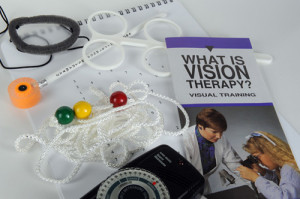 Vision Therapy is an individualized treatment program prescribed to eliminate or improve conditions such as lazy eye (amblyopia), crossed eyes (strabismus), focusing, eye teaming and learning-related vision disorders.
Vision Therapy is an individualized treatment program prescribed to eliminate or improve conditions such as lazy eye (amblyopia), crossed eyes (strabismus), focusing, eye teaming and learning-related vision disorders.
The key to understanding the relationship between vision and learning is realizing that vision is more than just being able to see the letters on the 20/20 line of a chart. Visual problems can be divided into two broad categories – visual efficiency and visual processing.
Visual Efficiency problems interfere with a child’s ability to clearly and comfortably see and take in information for sustained periods of time. Many of these problems don’t surface until the upper elementary grades or junior high, when children are required to cover significantly more reading material. Visual Efficiency problems include near-sightedness, far-sightedness, astigmatism, and problems with focusing, tracking and eye teaming.
Visual Processing problems have to do with the child making sense of incoming visual information. They include difficulty with laterality, directionality, visual form perception, visual memory, and visual motor integration. Visual Processing problems tend to affect children in the lower grades – even kindergarten.
A full evaluation by a professional who has the expertise to test for both Visual Efficiency and Visual Processing problems is the only way to detect some vision problems. When one of these problems does exist, treatment involving eyeglasses, Vision Therapy, or both can correct it. For 85% to 90% of patients with vision problems, glasses are the treatment option. However, the other 10% to 15% require Vision Therapy. In our office, we are proud to offer the services of Dr. Mitchell Scheiman, a leader in the field of Vision Therapy.
